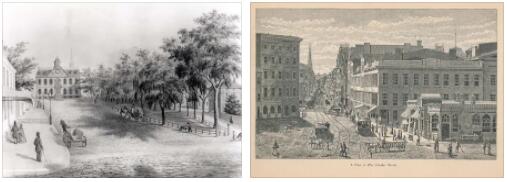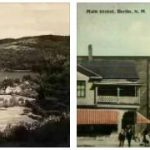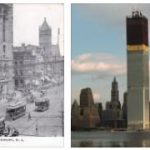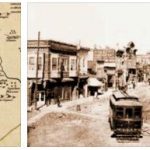Population: 1,051.302 thousand people (2011)
Area: 4002.0 sq. km
On the coast of the Atlantic Ocean in the New England region is the smallest US state – Rhode Island.
In the pre-colonial era, the Wampanoag, Niantic, and Narragansett Indians of the Algonquian peoples lived here. In 1524, the first European arrived in Narragansett Bay – the explorer Giovanni da Verrazano, who was on an assignment from the French king.
In 1611-1614, the Dutch explorer Adrian Blok also visited here. He also made the first map of the region. After 20 years, Roger Williams (a Protestant theologian) founded the first settlement of Europeans on this territory. This settlement was called “Providence Plantation”, which means “Providence”. In 1638 Anne Hutchinson was mortgaged the city of Portsmouth, also the “Colony of Rhode Island”. William Coddington founds Newport in 1639, and after 3 years a plantation appears (later the city of Warwick), founded by Samuel Gorton. In 1644, the above-mentioned colony cities are united and receive the status of “The Colony of Rhode Island and the Plantation of Providence”, officially confirmed in 1663 by the charter of Charles II. The Rhode Island Anti-Slavery Act was passed in 1652 and was the first in North America. The years 1675-1678 were marked for Rhode Island by the “King Philip’s War”, as a result of which the Indians lost their influence. Rhode Island Colony and Providence Plantation lost its independence in 1686, but after 3 years independence was returned.
On May 4, 1776, the province of Rhode Island was the first to declare independence from the British, and on August 29, 1778, the “Battle of Rhode Island” took place. 12 years later, on May 29, 1790, Rhode Island and Providence Plantation became part of the United States, becoming the 13th state.
During the industrial revolution in the state, the vast majority of workers did not have the right to vote. In 1842, after the suppression of the “Dorr Rebellion” in Rhode Island, a new Constitution was adopted, granting the right to vote to every free citizen.
Today, the state pays special attention to education, medicine, services and, of course, tourism.
PAWTUCKET
Population: 71.100 thousand people (2010)
Area: 23.3 sq. km
Founded: 1671
City status since: 1886
Time zone: UTC-5, summer UTC-4
Altitude: 11 m
Pawtucket is located in Providence County, Rhode Island, at the confluence of three rivers. Before the active colonization of these lands, indigenous people gathered here to jointly catch salmon that came to spawn at the mouth of the Seekonk River.
Pawtucket’s transport links are by road only. In the western part of the city lies the federal highway I-95. Trains only passing through with a stop in Providence. Pawtucket railway station was closed in 1981.
From its founding until the Great Depression of the 1930s, Pawtucket was the state’s largest industrial center. The first, fully automatic, water-powered weaving factory operated in the city; weapons workshop, shipyards and the first stamping press for the production of small metal parts. Profits from enterprises contributed to the active construction of luxurious residential buildings and public buildings in the city, gradually expanding its boundaries. By the beginning of the 20th century, Pawtucket had acquired his own cinema palace, called the Leroy Theater. The architectural structure in the best traditions of the colonial style has become one of the most beautiful buildings in the city.
The economic crisis of the beginning of the last century made its own adjustments to the life of the city: Slater’s cotton mill was stopped and at the present time turned into a museum of the Industrial Revolution of America. In the surrounding area with a waterfall on the Seekonk River, there is a city park, which is also part of the museum. The oldest house in America, once owned by John Daggett, has been preserved on its territory. Built in 1685.
The gunsmith building is now occupied by an art gallery and a cultural center that hosts the annual Pawtucket Arts Festival.
PROVIDENCE
Population: 178,000 thousand people (2010)
Area: 53.2 sq. km
Founded: 1636
Time zone: UTC-5, summer UTC-4
Altitude: 23 m
The capital and largest city of the smallest US state is Providence. The city is located on the shores of Narragansett Bay, where the Wunasquatuket, Moshassuk, and Providence rivers flow into it. The territory of the city is spread over seven hills.
The Narragansett Indian tribes lived here before the arrival of the colonists. Roger Williams, expelled from the Massachusetts colony, became the first white settler in these parts. In 1636, he bought land from the Indians, and when he saw it, according to legend, he exclaimed: “God’s merciful Providence!” (Merciful providence of God!). So the new settlement got its name.
In the early years of its existence, Providence was a haven for persecuted believers from other New England colonies of various denominations: Quakers, Baptists, Huguenots, Jews, Anglicans and Catholics. Because of this, it was nicknamed “the gutter of New England” by Puritans in neighboring areas. Later, in the 19th century, Providence turned into a major industrial and economic center of the region, where textile, machine-building enterprises, and jewelry workshops worked.
Modern Providence is a significant tourist center not only for Rhode Island, but for the entire Northeast of the United States. In the historical and business center of the city, many buildings in the Victorian style have been preserved, restaurants, galleries, museums, and many parks (including the zoo) are open. The most prominent sights of Providence include the First Baptist Church (1638), the School of Design Museum, the Rhode Island Capitol and the Arcade Washington, the first indoor shopping center in the United States (1828), which has been performing this function since the day it opened.
East Providence, Rhode Island
History and Climate of East Providence, Rhode Island:
History: East Providence, Rhode Island, has a rich history that reflects the broader narrative of colonial settlement, industrialization, and community development in New England.
- Indigenous Inhabitants: Before European colonization, the area that is now East Providence was inhabited by the Wampanoag and Narragansett Native American tribes. The Seekonk and Providence Rivers provided important resources for these communities.
- Colonial Era: The colonial period saw the arrival of European settlers in the 17th century. The land was part of the original Plymouth Colony grant and later became part of the Massachusetts Bay Colony. In the 1630s, Roger Williams, a religious dissenter, and Anne Hutchinson, a prominent religious figure, settled in the nearby Providence area, contributing to the establishment of Rhode Island as a haven for religious freedom.
- Settlement and Division: The land on the eastern bank of the Providence River was initially part of Rehoboth, Massachusetts. In 1862, East Providence, then known as Rumford, was incorporated as a separate town, with industries like farming and milling contributing to its economy.
- Industrialization: The 19th century brought significant industrialization to East Providence. Mills and factories, powered by the flowing waters of the Ten Mile River, became prominent features of the landscape. The city’s proximity to the waterways facilitated transportation and trade, contributing to its economic growth.
- Changing Names: Over the years, the town underwent name changes. In 1862, when incorporated as a town, it was named “Rumford.” In 1907, it was renamed “East Providence” to avoid confusion with Rumford, Maine. The name change signaled the city’s distinct identity within the state of Rhode Island.
- Urban Development: In the 20th century, East Providence continued to evolve as an urban center. Residential neighborhoods, commercial districts, and community institutions flourished. The city embraced a diverse population and became a thriving suburban area.
- Historical Preservation: East Providence has taken steps to preserve its historical heritage. Notable landmarks, such as the Newman Congregational Church, reflect the city’s architectural and cultural history. Efforts to protect and showcase these historical assets contribute to the city’s character.
Climate: According to Insidewatch, East Providence experiences a humid subtropical climate, with warm summers and cold winters, typical of the New England region.
- Summer (June-August): Summers in East Providence are warm, with average high temperatures ranging from the mid-70s to mid-80s Fahrenheit. The proximity to the Atlantic Ocean moderates extreme temperatures, and the city experiences comfortable weather. Residents and visitors enjoy outdoor activities, parks, and community events during the summer months.
- Fall (September-November): Fall brings a gradual cooling of temperatures, with average highs ranging from the mid-60s to mid-70s Fahrenheit. The changing foliage in the region adds vibrant colors to the landscape, making fall a picturesque time for outdoor excursions and community festivals.
- Winter (December-February): Winters in East Providence are cold, with average high temperatures ranging from the mid-30s to mid-40s Fahrenheit. Snowfall is common, and the city experiences winter chill. Residents engage in winter sports and festive holiday activities during this season.
- Spring (March-May): Spring sees a gradual warming of temperatures, with average highs ranging from the mid-40s to mid-60s Fahrenheit. As flowers bloom and trees regain their foliage, East Providence experiences a renewal of life. Spring is an inviting time for outdoor activities, gardening, and community events.
The climate’s maritime influence, thanks to its proximity to Narragansett Bay, contributes to relatively milder temperatures and moderates extreme weather conditions. The changing seasons provide residents with a diverse range of experiences and contribute to the city’s appeal as a place with a rich historical and climatic character.









